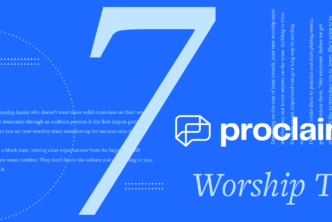One thing I’ve noticed over the years is that a lot of churches let things slide (pun intended) when it comes to worship lyrics and sermon slides. And I understand why.
Nearly 60% of all churches in the US have under 100 attendees and are operated by a pastor and a handful of volunteers. When resources are already spread so thin, it’s tough to create solid graphics without a full-time designer, and digging through free backgrounds and navigating copyright issues can be daunting.
Making effective, polished slides doesn’t have to be difficult though. You don’t have to be a designer to pull it off. A few simple adjustments can go a long way to optimizing your sermon slides.
1. Don’t show everything on one slide
While it’s important to show song slides a few seconds before people have to sing the lyrics, the opposite is true when it comes to sermon slides. Showing sermon points early breaks your flow and encourages the congregation to read instead of listening to you speak.
Instead, reveal one line at a time while elaborating on each point. I suggest one main point and no more than four sub-points per slide. Remember, when all your points are visible, people are reading your slides, not listening to you.
Note: If someone in the booth is changing slides during your sermon, explain that they need to wait for you to make your point before revealing it on the screen. This might mean giving a copy of your sermon notes to the slide operator or simply discussing some cues beforehand. If you’re using a remote, this is not a problem since you’re controlling the slides. Proclaim offers its own remote app that you can get for iOS or Android.
2. Choose visuals that enhance the message
This one is pretty straight forward, but I see it missed all the time. The point of a background is to add context without distracting from the main point. A well-chosen background can increase retention and reinforce your points immensely. A poorly-selected background, however, can be distracting. Select backgrounds that serve the message, and keep it consistent across every slide—choose one background per sermon. You can check out all the awesome graphics that we have available in Proclaim and use them absolutely free!
3. Use easy-to-read fonts
Script fonts look pretty, but are really difficult to read, especially on screen. Restrict the use of script fonts to headings or title slides, and never use them as your main font. When it comes to fonts, err on the side of simplicity. If people are trying to decipher your slides or are admiring the font, they’re not listening to you. You can read more about choosing fonts for your slides here.
Some fonts to avoid:
- Papyrus
- Comic Sans
- Times New Roman
4. Contrast
There’s a reason books have white pages and black text—contrast. For slides, use dark text on light colored backgrounds or light text on dark backgrounds. I recommend the latter because white is the brightest color your projector can display.
Some color combos to avoid:
- Red/Green
- Orange/Blue
- Red/Blue
Even if you have a light background, using a drop shadow or stroke can create enough separation between the text and the background. One of my absolute favorite things about Proclaim is that every slide is pre-built with styling that maximizes contrast, ensuring that your slides look great every week. I recommend testing this out so you can see how it works for yourself.
5. Keep it short
Less is more. Avoid putting your sermon notes on the slide. People should listen to your sermon to get the details, not read the slides.
A good rule of thumb is if your slide wouldn’t fit in a Tweet (140 characters or less) or takes longer than 10 seconds to read, it needs to be condensed or broken up into multiple slides. Remember: when people are reading your slides they’re not listening to you.
Bonus
Instead of presenting your outline as a numbered or bulleted list, limit yourself to one point or idea per slide. Try coming up with succinct points and breaking them up into individual slides. This will help your slides look cleaner especially when you have more than two subpoints.
Visuals are valuable but they need to be used well. These tips provide the basics, but the important thing here is to continue building on that foundation and experiment to see what works for you.





